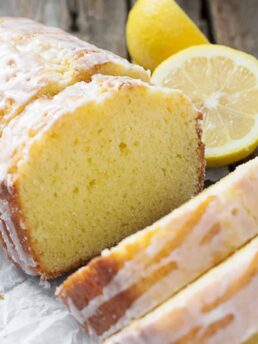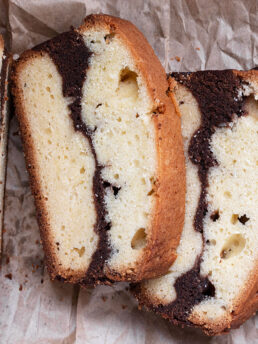A lovely and delicious pistachio loaf cake with a pound cake and a marble of pistachio-flavoured cake is all topped with a lemon glaze and pistachios.

This pretty pistachio loaf combines a delicious pound cake with a pistachio-flavoured swirl. Topped with a tangy lemon glaze and chopped pistachios.
Ingredients and substitutions
A few notes about the key ingredients …
Pistachios – For easy preparation, start with shelled pistachios, either unsalted or lightly salted. Of course, you can always shell your own pistachios if you like.
Sour Cream – Opt for full-fat sour cream (14% b.f.) for best results. A lower-fat sour cream won’t produce the same moist and tender loaf. In a pinch, full-fat plain yogurt (preferably Greek yogurt) would work, but again, the lower fat content will affect the finished loaf texture to some degree.
Lemon – You’ll need one fresh lemon for the juice used in the glaze.
How to make pistachio loaf cake
This is a summary of the steps to make this loaf cake. Always refer to the complete list of ingredients and instructions in the Recipe Card below to make the recipe.



- Start the loaf cake by creaming together the sugar and room-temperature butter. Beat in the eggs and vanilla.
- Add the flour mixture to the batter, along with the sour cream.
- Remove and set aside 1 cup of the batter.



- Spread a thin layer of the batter in a loaf pan.
- Add the pistachio swirl ingredients to a food processor and process until smooth.
- Add the pistachio mixture to the reserved 1 cup of batter.



- Fold the pistachio mixture into the reserved batter.
- Add the pistachio batter in dollops together with dollops of the plain batter to the loaf pan.
- Use a knife to make a few swirls in the batter then bake. When cool, glaze and sprinkle with pistachios.
Recipe tips!
- Room-temperature ingredients make a big difference in the quality of the finished loaf. So when you take the butter out of the fridge, take the eggs and sour cream out too.
- Remember that room-temperature butter is about 67F. It should yield to your finger, but you shouldn’t be able to push your finger into it.
- The other critical process when making a loaf like this is to properly and thoroughly cream together the butter and sugar. This should be done at medium (not high!) speed, which is speed 4 or 5 on a stand mixer. Scrape the bowl down once or twice and mix for the entire time specified.
- I am a big fan of the 4×10 loaf pan for this type of loaf cake. It makes for a taller, longer cake that makes for lovely slices. It’s a great addition to your kitchen if you enjoy loaf cakes.

Making ahead, storing and freezing
You can easily make this loaf a bit ahead, as it keeps very well. Store in an airtight container at room temperature for up to 3 days.
You can freeze this loaf, though it is best to freeze it without the glaze if possible, as the glaze can become wet from the freeze/thaw process. Freeze well-wrapped for up to 3 months.
Want to save this recipe?
Enter your email and I’ll send it to your inbox. Plus, you’ll get great new recipes from me every week!
By submitting this form, you consent to receive emails from Seasons and Suppers.
You can unsubscribe at any time.

Get the Recipe: Lemon Pistachio Loaf
Ingredients
- 1/2 cup (113 g) salted butter, at room temperature
- 1 cup (190 g) white granulated sugar
- 3 large eggs, at room temperature
- 2 teaspoons vanilla extract, or vanilla bean paste
- 1 1/2 cups (180 g) all-purpose flour, spooned and levelled
- 1/4 teaspoon salt
- 1/4 teaspoon baking soda
- 1/4 teaspoon baking powder
- 1/3 cup (75 ml) full-fat sour cream, at room temperature
Pistachio swirl:
- 1/2 cup (50 g) pistachios, shelled, raw or lightly salted
- 3 Tablespoons brown sugar
- 1/4 cup (60 ml) milk
Lemon glaze and topping:
- 1 cup (65 g) icing/confectioners' sugar
- 2 Tablespoons lemon juice, plus more as needed
- 1/4 cup pistachios, chopped
Instructions
- Preheat oven to 325F (non-convection/not fan-assisted) and grease an 8 1/2 x 4 1/2-inch or 4 x 10-inch loaf pan. Set aside.
- In a large bowl with an electric mixer or the bowl of a stand mixer with the paddle attachment, cream together the butter and sugar until light and fluffy at medium speed, about 3 minutes. Beat in the eggs, one at a time, beating well after each addition and scraping down the sides of the bowl as needed. Beat in the vanilla.
- In a medium bowl, whisk together the flour, salt, baking soda and baking powder. Add half of the flour mixture to the butter mixture, then add the sour cream, then add the rest of the flour mixture, mixing just until combined.
- Remove 1 cup of the batter to a medium bowl.
- Make the pistachio swirl by adding the pistachios, brown sugar and milk to a food processor. Process the mixture until it is very smooth. Gently fold the pistachio mixture into the reserved batter and set aside.
- Spread a thin layer of the plain batter into the bottom of your prepared loaf pan. Using a spoon, drop alternating spoonfuls of the plain and the pistachio batter into the pan. Top with a thin layer of the remaining plain batter and smooth the top. Using a long skewer or knife, run through the batter in the pan a few times (either lengthwise or from side to side). Just about three strokes lengthwise or 4-5 side to side should do it.
- Bake loaf in the preheated oven for 55-65 minutes, or until a tester inserted in the centre of the loaf comes out clean. (4×10 pan will cook more quickly, 55-60 minutes, while an 8×4 will take a bit longer, closer to 65 or a few minutes more).
- Allow the loaf to cool in the pan for about 10 minutes, then run a knife around the outside and remove to a cooling rack to cool. Allow the loaf to cool completely before glazing. Even a bit of warmth in the loaf could case issues with the glazing.
- Tip! To get a glaze that is thick and white as shown here, be sure that the glaze is not too thin. A thin glaze will run off the top leaving a translucent glaze instead of a white one. The consistency should be thicker than you might think. When dripped from a spoon back into the bowl, the glaze should very, very slowly blend back into itself, but do so eventually. If it holds its shape, it is too thick. If it blends back in immediately, it is too thin. When spooning the glaze onto the loaf if it is thick enough it will require using a spoon to coax it over the top and won't run off the top on its own.
- To make the glaze, add the icing sugar to a small bowl. Add the lemon juice a bit at a time, stirring it in well as you go. Add additional lemon juice if needed to make a glaze that slowly blends back into itself when drizzled from a spoon. If the glaze is too thin, add more icing sugar to thicken it.
- Spoon the glaze down the centre of the loaf and use the back of a spoon to gently coax the glaze towards the edges here and there, to make some drips down the sides. You want a nice layer of glaze on top, but you may not need to use all of the glaze. While the glaze is still wet, sprinkle the chopped pistachios on the top.
- Allow the glaze to set for at least 30 minutes before slicing.
Notes
More loaf cake recipes to love!
Hi! I’m Jennifer, a home cook schooled by trial and error and almost 40 years of getting dinner on the table! I love to share my favourite recipes, both old and new, together with lots of tips and tricks to hopefully help make your home cooking enjoyable, stress free, rewarding and of course, delicious!







Wonderful loaf! Nice texture and not too sweet.
So glad you enjoyed it, Megan :) Thanks so much!
I have this in the oven now… in the notes of the recipe you mentioned the lemon is needed for “the zest for the loaf”.
However, I didn’t see zest on the recipe card instructions. So I didn’t add any. Is there supposed to be zest?
Thanks!
Hi Tanya and no, sorry about that. When I was writing the notes I thought I had used some zest in the loaf but I didn’t (I probably thought about it though :) I’ve fixed the notes now.
Hi Jennifer,
I have a question. Why isn’t my lemon glaze white in colour, like yours? Mine is translucent even though I followed your recipe and used icing sugar with lemon juice.
Regards,
Sharon
Hi Sharon, if the glaze was translucent, it was too thin. When the glaze is too thin, it runs off the top of the cake instead of staying put. It should be thicker than you might think. I like to test it by letting some drip from a spoon back into the bowl. If it blends back in immediately, it is too thin, so I add some more icing sugar. Aim for a consistency that takes its time blending back in, but eventually does. With that texture, when you spoon it on top of the loaf, it won’t go far on its own and will need a spoon to coax it towards the sides. This will keep it thicker on top of the cake and whiter :) Hope that helps.